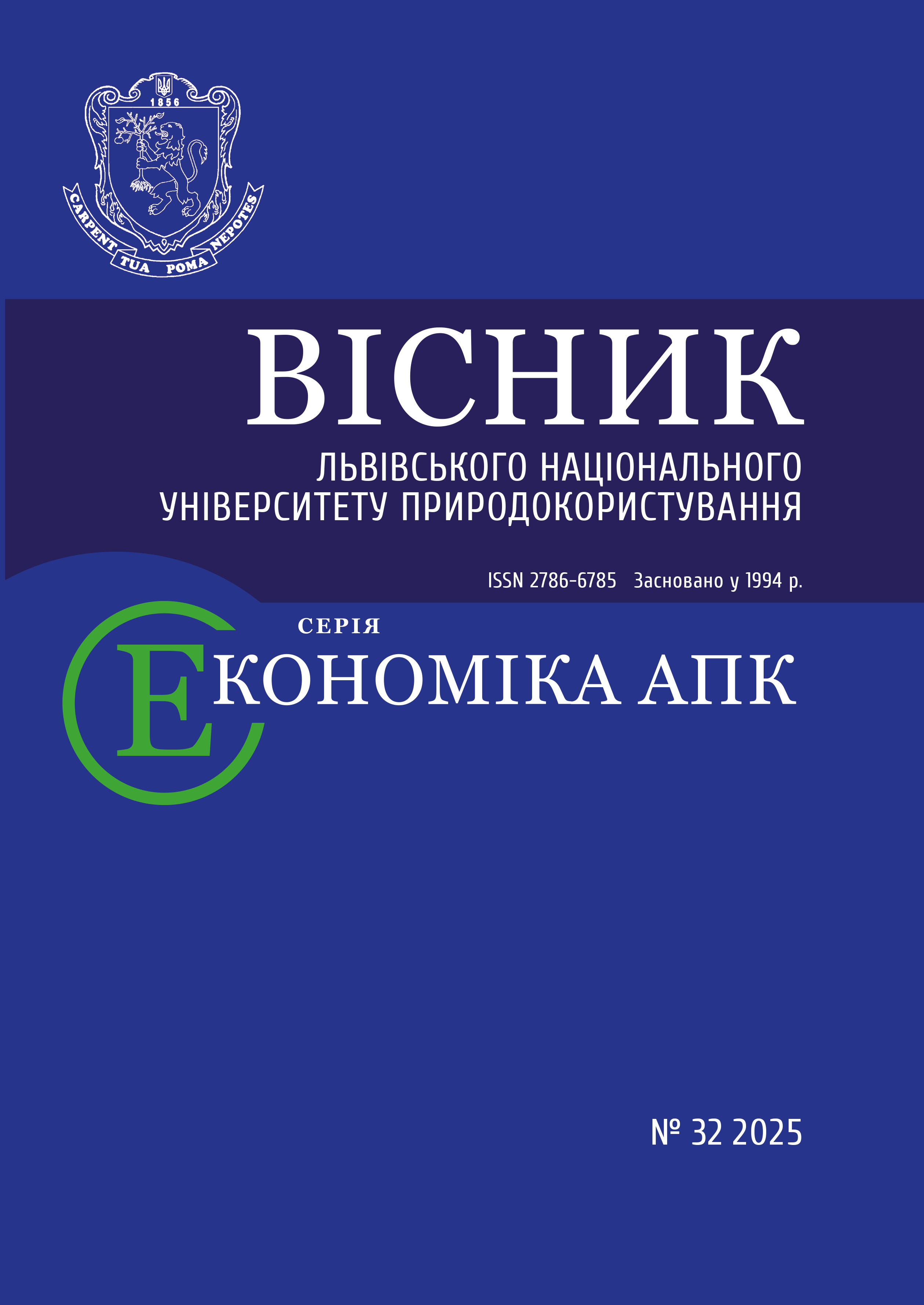ENSURING THE FINANCIAL EQUILIBRIUM OF AGRICULTURAL ENTERPRISES IN THE CONDITIONS OF WAR
DOI:
https://doi.org/10.31734/economics2025.32.023Keywords:
financial equilibrium, financial and economic security, agrarian sector, military conflict, logistical constraints, financial risks, state supportAbstract
The article examines the financial and economic security of enterprises in light of the contemporary challenges posed by crises, particularly military conflict. The authors highlight the critical aspects of financial equilibrium that contribute to the stability of business entities, including liquidity, solvency, capital structure, sustainability of financial flows, and adaptability to changes in the external environment. Special attention is given to the agricultural sector, which faces significant hardships due to the destruction of production facilities, constrained logistics, financial risks, and shifts in market demand. The article outlines key directions for state support for the agro-industrial complex, such as stimulating investment, enhancing access to financial resources, diversifying export flows, and developing anti-crisis strategies. The findings of this study can inform the formulation of effective policies aimed at the economic security of enterprises amidst instability. It identifies essential mechanisms for state incentives, which include preferential lending, the establishment of support funds, export credit programs, and tax incentives. Furthermore, the article gives particular emphasis to the “Affordable Loans 5-7-9” program, which is crucial for facilitating access to financial resources for agricultural enterprises. The analysis of financing volume reveals regional variations in loan acquisition and underscores the need for agricultural enterprises to secure additional funding.
The exploration of alternative financing sources for agricultural enterprises includes strategies such as attracting grants from international organizations, fostering cooperative relationships, utilizing leasing and factoring, engaging with credit unions, and leveraging P2P lending. These approaches aim to mitigate financial risks and enhance economic efficiency.
Additionally, the author addresses the significance of digitalizing financial management within agricultural enterprises, emphasizing its role as a vital tool for improving competitiveness. The text advocates for the implementation of ERP systems and the application of Big Data and artificial intelligence technologies to forecast financial risks. Furthermore, it underscores the importance of electronic document management to boost the transparency and efficiency of financial processes. The discussion highlights the potential for integrating digital technologies into financial management to effectively respond to modern challenges and promote the sustainable development of the agricultural sector.
References
AGRI-GATOR. Grant or loan: which financial instrument is most often used by farmers, and how successfully. 2023. URL: https://agri-gator.com.ua/2023/05/30/hrant-chy-kredyt-iakyj-finansovyj-instrument-najchastishe-vykorystovuiut-ahrarii-i-naskilky-uspishno-agroportal-ua/?utm_source=chatgpt.com (Accessed February 02, 2025).
Kostenko Yu., Korolenko O., Huz M. Analysis of the financial stability of the enterprise under martial law. Economics and society. 2022. No 43. https://doi.org/10.32782/2524-0072/2022-43-77.
Kurkul. Non-bank financing for farmers: what the market offers. 2024. URL: https://kurkul.com/spetsproekty/1555-nebankivske-finansuvannya-dlya-fermeriv-scho-proponuye-rinok?utm_source=chatgpt.com (Accessed February 02, 2025).
Kustrich L. Management of financial flows in logistics systems in the post-crisis period. Economics and society. 2022. No 45. https://doi.org/10.32782/2524-0072/2022-45-26.
Melnyk L. M. Financial equilibrium as part of the financial and economic security of enterprises. Bulletin of the National University of Water Management and Environmental Engineering. 2017. Vol. 2, No 78. P. 22–29.
Melnyk T. Yu. State support and stimulation of business development in Ukraine during martial law. Economics, management and administration. 2022. No 2 (100). P. 3–11. https://doi.org/10.26642/ema-2022-2(100)-3-11.
Official website of the Parliament of Ukraine. Since the beginning of 2025, 117 agricultural enterprises have received UAH 318.7 million under the Affordable Loans 5-7-9 programme. URL: https://www.rada.gov.ua/news/news_kom/257969.html (Accessed February 02, 2025).
Sak T. V., Shepeliuk N. P. Diagnostics of financial stability of the enterprise: methodology and practice of application. Economic Journal of Odesa Polytechnic University. 2023. No 4 (26). P. 37–44. https://doi.org/10.15276/ej.04.2023.5.
Teres Yu. Attracting foreign investment for the development of Ukraine's economy: wartime challenges and post-war prospects. Economics and society. 2023. No 51. https://doi.org/10.32782/2524-0072/2023-51-51.
Vlasiuk S. A., Tykhovskyi M. I., Lebid I. Yu., Zaiarna V. O. State financial support of the agricultural sector of Ukraine under martial law. Collection of scientific works of Uman National University of Horticulture. 2024. Issue 104. Part 2. P. 223–232.
Volkova N. I., Sarzhevska A. O. Alternative sources of financing for small and medium-sized enterprises in Ukraine. Finance, accounting, banks. 2018. No 1 (23). P. 39–47.


